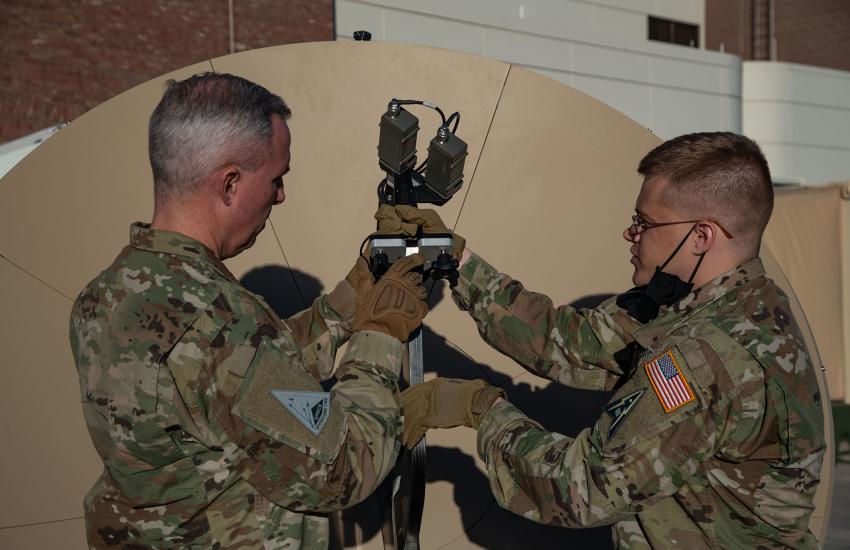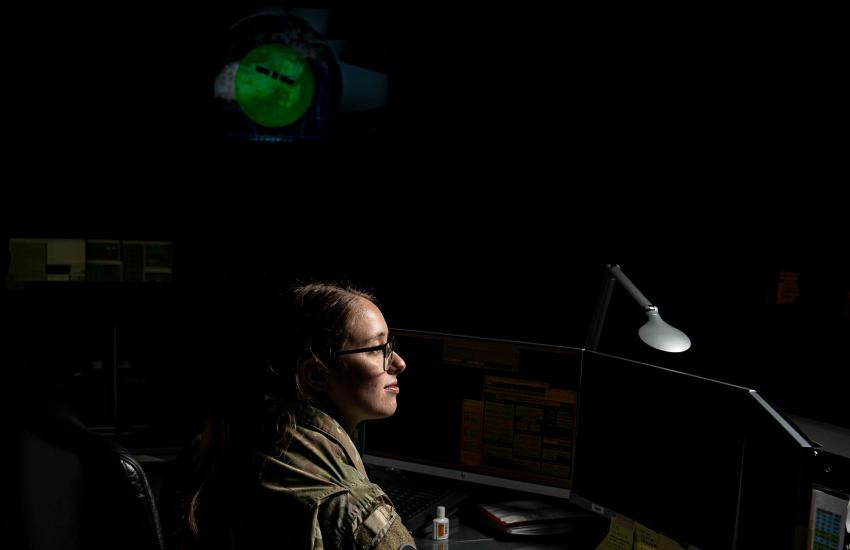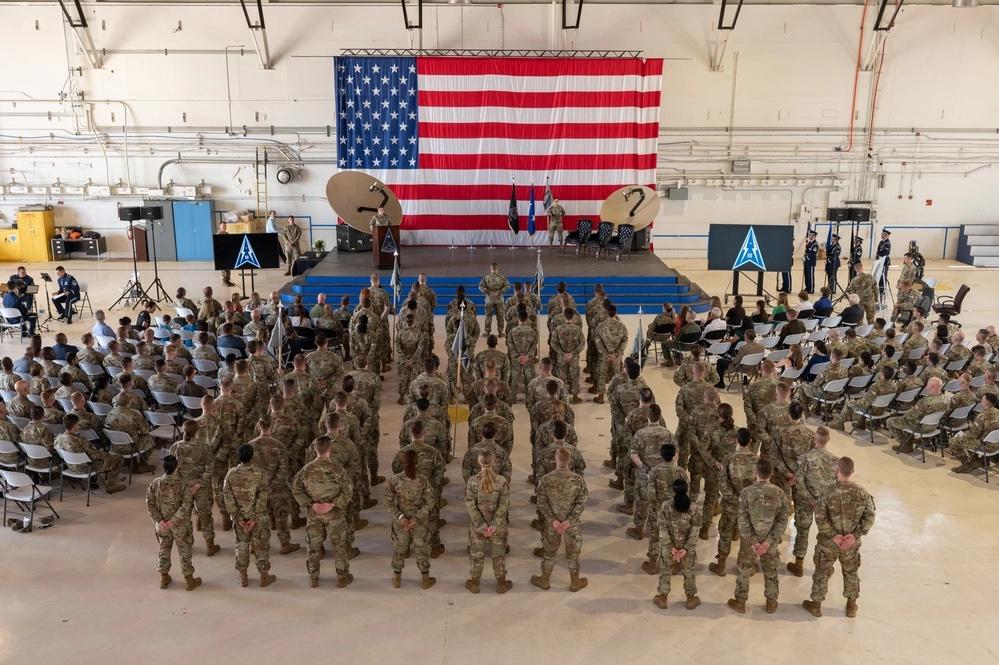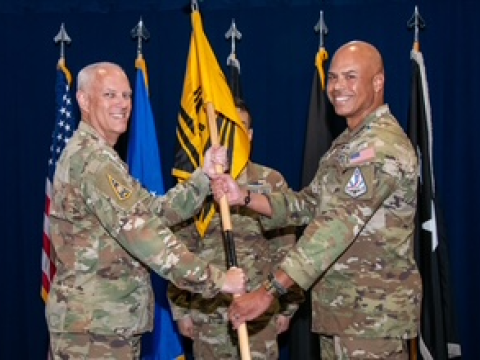The Space Force Sees Early Promise From Integrated Mission Delta Concept
The four-year-old U.S. Space Force is trying out a new organizational concept that leaders purport will provide greater readiness in the face of growing competition in the space domain. As part of the so-called Integrated Mission Delta (IMD) prototyping effort, the service created two deltas that will combine operations, as well as maintenance, acquisition, cyber and intelligence functions.
U.S. Space Force Chief of Space Operations Gen. B. Chance Saltzman announced the pursuit of the concept last September at the Air and Space Forces’ annual conference. The two IMD mission areas include position, navigation and timing (PNT) and electronic warfare. With success, the Space Force aims to replicate the concept across the service.
The shift to integrate resources in mission areas, placing Guardians, technology, training and sustainment into one delta—instead of separating out operations, acquisitions or cyber, for example—has already offered early efficiencies, explained Col. Carl Bottolfson, director, Futures and Integration, U.S. Space Force.
Both of the IMD prototype organizations are aligned under the Space Force’s warfighting arm of Space Operations Command, which also serves as the service’s component to the U.S. Space Command. The IMD effort is part of the Space Force’s shift to operate in a contested, near-peer environment against adversaries such as the People’s Republic of China, the colonel said.
“[Looking] through the lens that the deltas are our warfighting organizations, we have to make sure that we are presenting ready forces for the combatant commands,” Col. Bottolfson stated. “We recognized that the delta commander, whoever that might be, does not control all of the elements that generate readiness. The delta commander has command of his or her troops and the capabilities. But one of the key elements that they do not have control of today is the maintenance activities. When things break or do not come online fast enough, that Delta commander has no real authority.”
The two provisional deltas have similar components—a commander, deputy commander, command staff, assigned squadrons, detachments or units, and operators. The organizations also include intelligence and cyber components as well as tier-one maintenance activities. From the Space Force’s acquisition arm, the Space Systems Command, the service pulled the related acquisition personnel and placed them within the delta construct, either as a detachment or a squadron depending on their size. “We’ve also taken elements that were part of the Intelligence Delta and placed those directly within the operational delta, either a squadron or part of the staff,” he said. “But the makeup of those two provisional deltas is a little bit different. We don’t necessarily want to have cookie-cutter deltas.”
Notably, Space Delta 3–Space Electronic Warfare, is led by an operator and the second in charge is an acquisitions leader, while the PNT provisional Delta is led by an acquisition leader and the second in charge is an operations person. This is a unique leadership arrangement that is already yielding results.
“In our two betas, Electronic Warfare is led by an operator and then PNT is actually led by an acquirer,” Col. Bottolfson shared. “To fill out that command team, the other O-6 has the opposite background of what the commander has. We’ve never done that before. But we have instantly gained an increased level of how things work in the delta. It ties back to that whole unity of effort. When you have two individuals that have those experiences, they know where to go, they know who to talk to and to get things done. And we’ve already seen that there’s been some increase in effectiveness in both of the deltas as a result of that pairing.”
Col. Marc Brock, director of Combat Power at the Space Operations Command and lead for standing up the IMDs, reported that since the creation of the two IMD deltas in October, “we have already seen significant gains in having increased collaboration between our sustainers who are now embedded within our deltas and the operators, who can more quickly identify requirements, identify challenges and provide feedback on material solutions.”
Within Delta 3, especially, the Guardians have really strengthened both the communications and the feedback loops between the operators and the acquirers regarding sustainment efforts for electronic warfare assets, with similar inroads in the PNT Delta, Col. Brock said.
The IMD leadership constructs also provide additional opportunities for the O-6 officer—and not just for the traditional 13-S operators. “It gives some of those officers, especially in cyber and in intelligence, some prospects for upward mobility, and that are at the operational level,” Col. Bottolfson noted. Whereas before, like most intel officers, they would run a squadron and then potentially a group, if one even existed, but then it was a staff assignment. Now they have an opportunity.”
From his perspective as the previous commander of Space Delta 2–Space Situational Awareness, Col. Brock sees great promise in the concept as it organizes responsibility into the delta construct. By allowing a single commander to be responsible for sustainment functions, some of the capability upgrades and the operations, it gives the vast majority of the readiness decisions to one commander.
“As a graduated delta commander, I could tell you flat out that I wish I had had the opportunity to lead an IMD,” he shared. “In the past, as the Space Delta 2 commander, if we had a required improvement for one of our systems, I had to prioritize my requirements, work with my logistics team and my technology director to come up with that prioritization and understand the pros and cons of the prioritization. Then we had to communicate that to the acquirers, and we’d have deliberations and discussions. In the end, the acquisition team would typically meet my priorities, but from time to time, they couldn’t or had to support other priorities. Now, these IMD commanders, they have the ability to directly make decisions on those priorities and direct those sustainers to make the needed changes and improvements. That all happens in-house now, as opposed to being a discussion between two separate organizations.”


The Space Force chose electronic warfare as an IMD because it is a unique mission set that constantly deploys capabilities and personnel. “That provided a good test bed,” Col. Bottolfson shared. Meanwhile, selecting the PNT provisional organization, whose personnel came partly from existing Delta 8, provided an organizational expansion opportunity. “On the other side of the spectrum, the position, navigation and timing side of the house is a very long-standing mission set,” he continued. “And when we stood up the service, PNT was combined with satellite communications. We took the PNT side out of that and established, rightly so, its own delta, provisionally.”
Creating the two IMDs has not necessitated huge shifts, Col. Brock explained. The PNT IMD moved to having a deputy commander with acquisition experience, just as the delta moves forward on the production of the GPS III satellites and the delivery of the GPS Next Generation Operational Control System, known as the OCX. “Those are fairly significant acquisition efforts, and so, the vice commander is an acquisition professional that’s really helping guide those efforts for the IMD,” he stated. “And for the electronic warfare delta, with the intel that we’ve embedded, we’ve had to provide some education to that commander on intel authorities. But overall, those are probably the two biggest changes.”
The Space Force will spend no more than a year evaluating the IMD concept, performing analysis and identifying lessons learned with the delta personnel and headquarters staff. “We’ll take that information back to the CSO and use that to inform future mission areas that he may consider for the IMD effort,” Col. Brock explained.
And although there are no other mission areas selected to undergo the IMD effort at this time, there is a lot of interest from other deltas to become an IMD. “The word is out,” Col Brock shared. “There is a lot of excitement, and so we are doing some internal planning to identify which mission areas we may propose to the CSO as the next ones. Pretty much, the majority of the delta commanders have come to me personally and said they’re excited to have the opportunity to be the next one.”
Expanding the scope of the IMD prototyping effort beyond two deltas would require more changes at the higher echelons and commands in how they would be supporting the IMDs, Col. Bottolfson said, adding that “we’d have to take a very close look at what the second and third order effects are down the chain as we consider expanding in the future.”
From the point of view of the Space Operations Command, Col. Brock sees the command as having a greater role because of the IMD’s responsibility for sustainment functions and some capability development functions. “Really what this IMD effort does, it just makes it more effective for the SpOC to perform those functions,” he stated. The command’s main function to present, generate and sustain capability to support operations in, through and from space does not fundamentally change at all.
“Secretary [Frank] Kendall has been pushing the entire Department of the Air Force, both the U.S. Air Force and the Space Force to really look at how we can optimize our organizations for great power competition, and that, more than anything, is what drove our service to look at how we can reorganize internally to be more effective,” Col. Bottolfson said.
“We activated the service just a few years ago, and we had significant change in structure when we went from the Air Force to the Space Force,” Col. Brock added. “Now we’re undergoing another improvement to really get after improving our effectiveness when dealing with some of the challenges we have within the domain.”




Comments